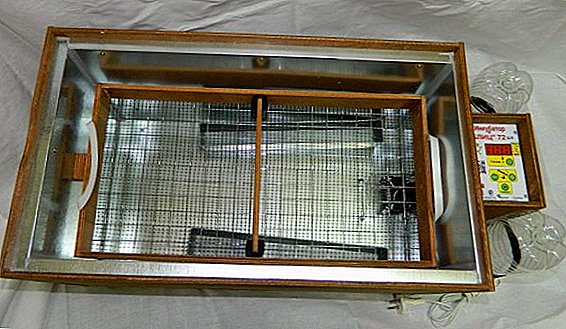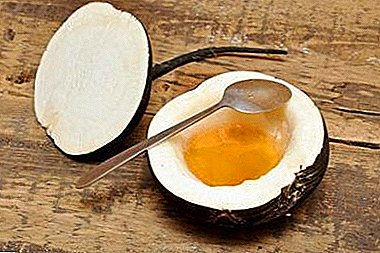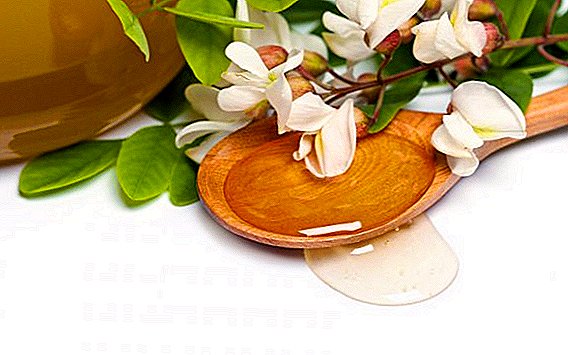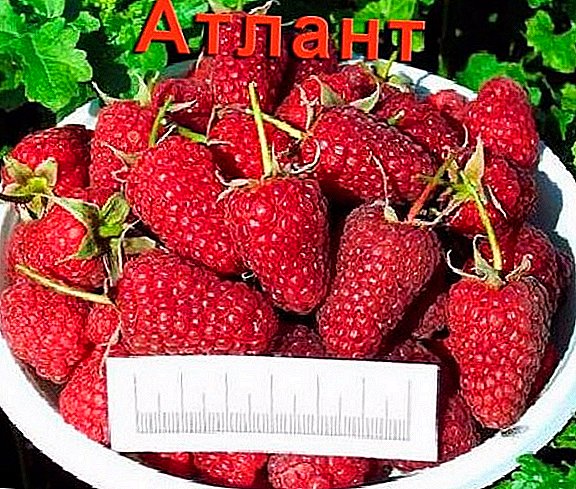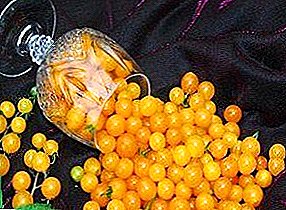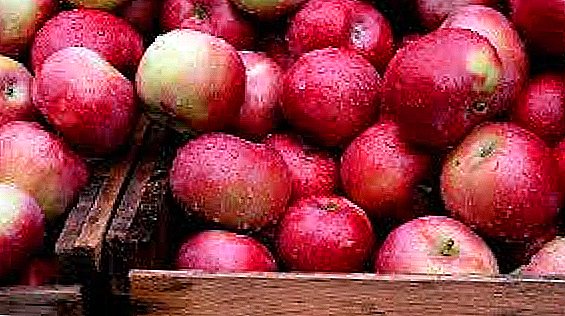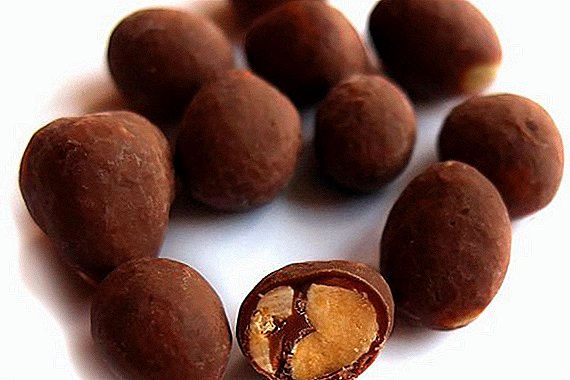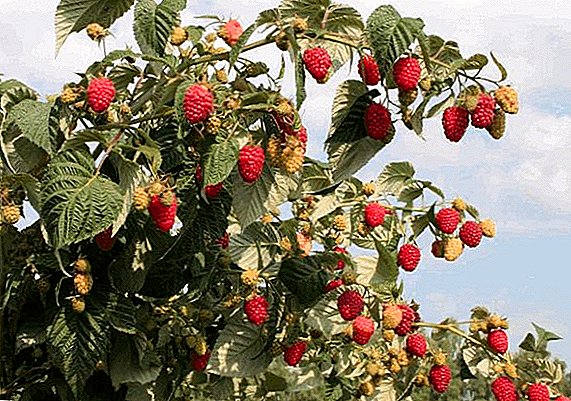 The employment of modern gardeners is constantly pushing them to search for a new raspberry variety, which combines several useful qualities - ease of care, no prickles, which can be injured while harvesting, a large and tasty berry, high yields and no need to tie plants to the support . All these qualities are characteristic of Crimson "Krepysh". This article provides advice to gardeners on how to choose a sapling of this raspberry variety, how to plant and how to care for it in the future to ensure a good harvest of berries.
The employment of modern gardeners is constantly pushing them to search for a new raspberry variety, which combines several useful qualities - ease of care, no prickles, which can be injured while harvesting, a large and tasty berry, high yields and no need to tie plants to the support . All these qualities are characteristic of Crimson "Krepysh". This article provides advice to gardeners on how to choose a sapling of this raspberry variety, how to plant and how to care for it in the future to ensure a good harvest of berries.
Selection
The raspberry "Krepysh" or raspberry tree is one of the finds of the famous Russian breeder V. Kichina. Raspberries obtained at the beginning of the two thousandth's in the nurseries of the Kokinsky strong point.
Check out the raspberry varieties of this variety as "Canadian" and "Tarusa".

Description and features
"Krepysh" - large-fruited medium early varietyits ripening begins from the second decade of June and lasts until the twentieth of July. The highlight of the variety is that its bushes do not need a garter and there are absolutely no thorns on them. They are thick and erect - freely hold a huge crop on their branches, which do not even lean under the weight of the fruit.
Bushes
Raspberry "Fortified" is a thornless berry bush, with a limited point of growth. Fruiting of this variety comes in the second year of life of the shoots. The adult raspberry gives a crop and dries out, its place next year will be taken by the present green growth.
The height of the vines of this raspberry varies from 1.4 to 1.8 m. The variety has very thick stems, the diameter of the sturdy vines reaches 1.5-2 cm. There are very small internodes on the stems, which guarantees the appearance of a large number of side branches, on which the main crop will be formed.
On the raspberry branches absolutely there are no spikes, the peel on the trunks of plants is smooth, like on currant bushes. Young single-stem stems have a green stem color, a biennial plant changes the color of the trunk to pine-yellow.  The shape of the bush begins at 30-40 cm from the surface of the soil, the leaves are dark green, rough, with a strongly corrugated leaf blade. At the top of the bush, the leaves are arranged in a crowded tuft. A two-year-old raspberry bush of this variety gives very few young shoots, which, on the one hand, makes its reproduction difficult, and on the other hand, the gardener does not have to fight every year with the uncontrolled shoots of raspberries that fill his garden.
The shape of the bush begins at 30-40 cm from the surface of the soil, the leaves are dark green, rough, with a strongly corrugated leaf blade. At the top of the bush, the leaves are arranged in a crowded tuft. A two-year-old raspberry bush of this variety gives very few young shoots, which, on the one hand, makes its reproduction difficult, and on the other hand, the gardener does not have to fight every year with the uncontrolled shoots of raspberries that fill his garden.
The fruiting area on the raspberry of this variety is located in the second upper half of the stem. Laterals (side branches) are not long, the berry sits on them compactly. Berries do not ripen at the same time., from the inflorescence of the formed berries (in the amount of 6-9 pieces) in the ripeness stage there can be only one - the rest will be green, and their gradual maturation will stretch up to 10 days. Harvesting from raspberry bushes, on which there are no thorns at all, is sheer pleasure!
Did you know? The very first party of settlers, who arrived on the American continent, found thickets of prickly bushes with black berry - it was a black raspberry, but it did not receive popularity among new settlers. At the end of the 18th century, the British brought raspberries with the traditional red color of berries to New World. The plant got accustomed and spread in America. But for raspberries with black berries, demand arose only in the 19th century.
Berries
The bushes of this variety are covered with large berries. The yield of raspberry "Fortress" is very high, but the berries are tightly seated on the stone, and when removed, they can crumble into fragments. If the berries are not picked on time, they will not crumble, but will gradually dry out on the fruit sprigs.
You can also plant different varieties of yellow and black raspberries on your plot.
Characteristic berries:
- dull red, not shiny;
- berries are very large;
- the weight of one raspberry 7−9 g;
- the berry has the shape of a wide cone, similar to a round cap that can be put on your thumb;
- fruit taste - sweet with a slight sourness;
- the berry firmly rests on the drupes, but with a rough removal from a branch it can crumble into fragments.

Ripening and yield
Fruiting of this variety starts from June 15-17 and lasts until July 10-15. Terms of ripening berries can move in one direction or another. This is influenced by the weather: in sunny weather, ripening is faster, and with prolonged rains the berries ripen more slowly and their taste changes for the worse.
In the characteristics of this variety declared yield of 4-5 kg of berries from a well-developed adult raspberry bush. In practice, the yield of the Krepysh variety on ordinary horticultural plots (when grown without the use of super-agro methods) varies within two to three kilograms of fruit from a bush. But it is also very, very high yield.
Winter hardiness
"Fortress" has been grown for over ten years in different regions of our country, which means. Passed extensive trials of heat and frost. Cultivation practice has shown that this variety is frost-resistant and without any harm for itself tolerates short-term frosts. to -30 ° C. Low temperatures to -20 ° C are generally not critical for the Raspberry Krepysh.

Using
Large beautiful berries "Krepysh" juicy and sweet. The ratio of sugar and acidity in them is very harmonious. The berries are quite transportable and allow transportation over short distances. During the period of mass ripening, raspberries become so juicy that during transportation they release the juice after three to five hours.
Therefore, this berry is transported in the first half of the fruiting variety (until the end of June) - further fresh transportation is meaningless. Due to the excellent taste and juiciness, the berries are used to make juices for baby food, sweet liqueurs, jams, jellies, mousses, confiture and compotes.
The classic recipe of raspberry confiture -"five minutes":
- a kilo of berry is passed through a meat grinder or ground by a blender;
- crushed raspberries are placed in a container for boiling jam and set on fire;
- 1 kg of sugar is added to a well-heated berry puree and boil over low heat;
- from the moment of boiling, the sugar mixture is boiled for 5 minutes.

Raspberry confiture, "five minutes" is ready, it is poured into jars and left for winter consumption.
Did you know? In Russian folk songs and proverbs, raspberry berries symbolize a good life - “Alien - viburnum, homeland - raspberry” or “Not life, but raspberry”.
What qualities should have a good, healthy raspberry seedling "Burly":
- young seedling shtambovogo grade should have a trunk diameter in diameter of not less than 1 cm;
- the base of the stem should have several well developed buds, fruit vines will grow from them;
- for young raspberries, a well-branched root system with many small roots (lobe) is important;
- it does not matter at all whether the proposed seedling is trimmed, since the stem of a raspberry is still trimmed when planted.
Important! Raspberry roots quickly dry in the sun or in the wind. To prevent this, purchased seedlings (root system) are wrapped in a damp cloth. It is necessary to try to plant raspberry saplings as quickly as possible at their intended place.
Choosing the right place
Raspberry loves cozy, windproof areas. When choosing a place, it is necessary to take into account the preferences of the plant and lay the future raspberry jam under the protection of the fence or wall of any building. Summer winds do not interfere with the plant, but winter, icy winds that carry frost with them, can lead to freezing of crimson landings.
Repair raspberry varieties such as "Indian Summer", "Hercules", "Heritage", "Atlant", "Zyugan", "Caramel" are gaining more and more popularity.
Lighting
Raspberry responds well to landing in well-lit areas. If the summer resident has such an opportunity, then the rows of raspberry rows should be located from south to north. Such an agronomic reception will allow the plant to be sunlit during the day longer. Raspberry plantations, planted in sunny and humid places, produce higher and better quality crops than those located in the penumbra.
The soil
The Krepysh raspberry plantation can only show the yield declared in the characteristics of the variety if it is planted in well-fertilized soil. 
Raspberry ground should have:
- Loose composition, which well passes oxygen and moisture to the roots;
- A sufficient amount of minerals and nitrogen.
Preparatory work before landing
If on the summer cottage dominated by poor soil, containing clay, they need to make lime (chalk) in the form of powder or wood ash. These substances are scattered on the ground before it is dug up. The introduction of these substances is simple to calculate: for every square meter of land they take a pound of lime and 2-3 handfuls of wood ash.
To increase the soil fertility, natural fertilizers (cattle manure, humus or compost) or mineral fertilizers containing nitrogen (nitrate, nitroammofoska) are applied to the future raspberry ground;
All fertilizers are also laid out on the ground and are buried in the soil by digging. Fertilization can be combined with the application of chalk, lime or wood ash.  Natural fertilizers are applied at the rate of 10 kg of manure or humus per square meter of berries. Mineral fertilizers are measured by gardeners in matchboxes: one matchbox of nitrate or three matchboxes of nitroammofoski per square meter of soil.
Natural fertilizers are applied at the rate of 10 kg of manure or humus per square meter of berries. Mineral fertilizers are measured by gardeners in matchboxes: one matchbox of nitrate or three matchboxes of nitroammofoski per square meter of soil.
Did you know? Snow-white raspberry flowers in the period of flowering overturn the cup down. This feature is successfully used by bees - even if it is raining outside, the bee, while working, is under the natural "an umbrella" and does not break through the honey collection for a minute. Bees are pollinators of raspberries and increase its yield by 80-100%.
Planting seedlings on the site
Before planting on the site a new variety, you need to mark up the beds for the future raspberry. The marking of the beds is carried out with the help of pegs and a cord stretched between them.
Along the borders of the beds, after the cords are stretched along its borders, fertilizers are laid out on the soil surface. Next raspberry should be dug up. And the last stage of forming a raspberry bed: the gardener, passing along the future berry, rakes the soil from the middle of the bed to its sides.

The bed turns out to be slightly arched towards the middle (like a trough or a boat). Such a form will help the plant driver in further caring for plantings: by watering the beds or by applying liquid fertilizers, you can not worry that the liquid will flow out of the raspberry field. All the moisture will leave exactly the roots of the plants for which it was intended.
Landing pits are digging along the finished markings for landing. It is not necessary to lay fertilizer in them, since the soil under the raspberries is sufficiently fertilized beforehand. Pour a bucket of water into each pit and, after soaking, set up a seedling with neatly straightened roots. The plants are covered with earth and watered again. This contributes to the fact that the soil is compacted and envelops the roots of seedlings.
Timing
Raspberries can be planted in autumn and spring, but during autumn planting young plants have more time for adaptation and rooting than in the hot summer period.

If the gardener decided to hold a spring planting, then it should be done in early April, before the leaves bloom on raspberries. In the fall, seedlings are planted from late September to late October.
Scheme
Raspberry tree "Krepysh" is a standard and not too high variety, so the distance when planting between two berry beds can not be made more than 1.5 meters. This is a convenient distance for further care of raspberries.
Important! The width of the future berry bed is no more than one and a half meters. A bed of precisely this width allows the gardener to conveniently pick berries, even in the middle of a raspberry leaf.
"Fortress" can be landed:
- in a single row landing - when the width of the berry beds in 1.5 m plants are planted along the beds in one row (keeping to the center). The distance between the seedlings should be at least 50 cm. In the process of growth in the following years, the roots of the raspberry will fill the whole bed.
- in a two-row landing - with the same width of the beds, as in single-row planting, the plants are planted in two rows.
Important! In order to correctly mark the presence of two landing rows relative to the center of the bed, from the middle of the bed measure 35 cm to the left, this will be the left row of the raspberry. In the same way, they retreat from the center of the bed 35 cm to the right - the second row of landings will begin here.
The distance between raspberry seedlings is 50 cm, the distance between two rows is 70 cm. When planting, the seedlings in adjacent rows are arranged in a staggered pattern.


Seasonal care features
Planting a good raspberry variety itself will not provide summer residents with abundant harvests - be sure to take care of it all year round: fertilize, water, cut, protect from diseases and pests, mulch. If the gardener complies with all these conditions, plantings will be healthy and fruits will be plentiful.
Watering and mulching
One of the conditions for obtaining a good harvest when planting raspberry "Krepysh" in the open field is good care and the complete absence of weeds in the garden. Monotonous weekly weeding not only exhausts the gardener, but can contribute to mechanical damage to the roots of berry bushes.
This can be avoided if the bed is mulched early in the spring. For mulching, you can use sawdust, shavings, last year’s leaves, peanut husks or sunflower seeds.

Raspberries loves watering very muchwithout enough moisture, raspberry flowers can crumble without tying berries. Raspberry roots are not spread deep, but rather horizontally below the surface of the ground. Therefore, without getting water, the roots dry quickly, and the plant may die.
During the fruiting period crimson beds need weekly abundant watering. If there is a water supply on the plot, then it makes sense for the gardener to spread out along the planted rows of a drip irrigation tube.
So watering will not take time gardener, and moisture will go to the roots of plants regularly and on time. On the 10-meter bed of raspberry plant you will need 300-400 l of water.
Top dressing
During the growing season, the plants pull out all the nutrients from the ground, and the gardener must replenish them in the soil. The best fertilizer for berry crops is natural organic fertilizers. They have the right raspberry nitrogen, calcium, potassium, and phosphorus.
And the most important thing is that all these substances are in a state accessible for consumption by plants. In order to conduct dressing with organic matter in a dry form, it is simply spread (laid out) under the root of vegetative plants.
If organic fertilizers are not rotten, of them prepare liquid concentrated infusion:
- one shovel of fresh chicken dung or cow dung is put into the bucket;
- filled with clean water to the top and closed with a lid;
- capacity is placed for fermentation in the sun;
- once every three days the contents of the bucket are agitated using a wooden mixer;
- after 10-14 days concentrated fertilizer is ready for use.
Important! The fertilizer of this recipe is too concentrated to be applied without diluting it with water. For every 10 liters of water add 0.5 liters of concentrate, stir and pour raspberries.Feeding with wood ash is very useful, there is a lot of potassium in it. It is introduced by simply sprinkling it at the roots of a plant or pollinating ashes raspberries over a leaf.
 Wood ash does not require accurate dosage when making, one or two handfuls per square meter is enough.
Wood ash does not require accurate dosage when making, one or two handfuls per square meter is enough.The introduction of ammonium nitrate will give the berry nutrition with nitrogen. To this end, in winter or late spring, even in the snow, a mixture consisting of ammonium nitrate and urea is scattered over the raspberry pancake. For each square meter of berry, a dose of 10 g of ammonium nitrate and 8 g of urea is calculated. Together with the melt water, the fertilizers will be washed away and absorbed by the roots of the plants.
Did you know? Fans of the "green snake" will be able to get rid of a serious hangover, after eating a handful of raspberries, in the cure they will be helped by fruit acids contained in the berry.
Preventive treatment
If the gardener neglects the preventive treatments of the berry, he will not get a good harvest. The main processing raspberries are carried out immediately after the snow melts and the soil dries out in the garden. 
Experienced gardeners try to carry out all the treatments before the raspberry buds swell and begin to blossom:
- To increase the immunity of plants to raspberry diseases (anthracnose and gray rot), urea is treated (15–20 g per square meter) and treated with copper sulfate solution (50 g of the substance is mixed with 5 liters of water).
- Further processing of plants with copper sulfate is undesirable, since raspberries tend to accumulate it in the form of nitrates in berries.
- If the disease has already begun with anthracnose, powdery mildew or raspberry rust, then planting can be cured by spraying with Bordeaux liquid (Topaz and Nitrofen preparations).
- The main enemy of raspberries is a raspberry weevil. The main attack of this insect on raspberries begins during the formation and pouring of the berries, so you can only fight with biological preparations.
- For pest control gardeners prepare mustard infusion. In 5 liters of cold water 10 g of dry mustard is added, it is all mixed up, covered and left to stand overnight. In the morning, the infusion is ready to eat. Apply it to the plants with a garden sprayer.
Important! If you mumble the soil of the berry beds from early spring with a thick layer of pine or spruce needles, then the crimson weevil will not even appear in such plantings. It is frightened off by a coniferous smell.
Support
Standard raspberry does not need additional supports. Due to its thick and durable stalk, it does not bend even in very strong wind. Standard raspberries are very convenient to grow in industrial plantings, which occupy dozens of hectares at once.
She herself is a mainstay, and the farmers have to spend extra money on the installation of mobile trellis and plant garters. Raspberry "Krepysh" without outside help keeps its considerable harvest on the branches.
Pruning
Pruning raspberry "Krepysh" is carried out in the spring, as soon as the warm weather sets. Immediately you need to clean the raspberry from the dead, cutting it with garden shears at the base of the bush. The berry branches that will bear fruit this season (the stems of the second year of life) cut the tops by 10-15 cm. This will help to properly distribute the crop throughout the raspberry stalk and stimulate the formation of lateral fruit branches.
Particular attention when pruning a gardener must turn to the thickening of the raspberries. One square meter of the berry should be no more than 12-15 raspberry stalks. The excess vine is also cut out by the shears from the ground itself and taken out of the site.
Preparing for the winter
In order to "Krepysh" win over without problems, he needs to prepare it. For this, the gardener at the end of the warm season (August - mid September) feeds the crimson nursery with phosphorus and potassium. Potash and phosphate fertilizers give impetus to the additional development of the root lobes of the plant and the ripening of the aboveground stem. Plants with a powerful stem and mighty root system calmly and without stress will survive great frosts.
With such top dressings supporting during the winter period in no case must not apply nitrogen fertilizers. Nitrogen-containing substances do not strengthen plants, but stimulate them to rapid vegetative growth. Instead of preparing to survive the cold period, raspberries begin to actively grow the leaves. These leaves will fly in a month, but the plant will give them the necessary strength for wintering.
In the agricultural technology of growing raspberries there is such a procedure as subwinter moisture irrigation raspberry cake

The bed with raspberries is watered before the onset of the first frost (late October - early November). For each square meter of berries should pour up to 50 liters of water. To carry out such watering in the winter - it means to ensure a good harvest of berries for the next year.
The description of the raspberry variety Krepysh includes a good winter hardiness, but if there is little snow in winter and frosts above -15 ° C, the gardener can help his plants survive the cold. With the help of a shovel you need to get snow in a raspberry bed. This will protect the shallow roots of raspberry from frost and serve as additional moisture-charging irrigation in spring.

The raspberry tree appeared in our gardens not so long ago, but, having passed the test of snow, rain, frost and lean years, with honor survived all the hardships. Every year the variety pleased summer residents with an excellent harvest of large and fragrant berries. Raspberry "Krepysh" in our berry-stands was not a random guest, but a full-fledged resident.


